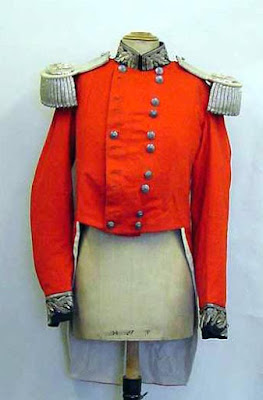A history placement student’s
perspective
 |
Leeds tailors John Wales Smith & Sons made
the Lord Lieutenant of Yorkshire's uniform
|
During my time at Abbey House Museum I
was asked to research the history of various Leeds businesses. For
this I used many fantastic resources, such as
the massive collection of street directories.
These allowed me to
track the businesses and find when they first
opened and closed, changed
hands or address. I was able to answer
quite a few of these questions but some companies were more difficult
to find in the directories.
One problem that I faced was that some
directories are missing leaving gaps in the dates I had found. I
found that you could be closely following a successful business when
it would disappear and I wouldn’t be able to track the exact date
that it closed down.
Another resource that I used was Ancestry.com. I used this website to find
information on individuals such as business owners. This sometimes
gave me more in depth detail such as who founded the business or why
a business shut down, such as death of the owner.
 |
This receipt revealed that John Wales Smith and
Sons were undertakers as well as tailors |
Case Study: John Wales Smith & Sons
One business that I found interesting was John Wales Smith and Sons Ltd, the tailors who
made the uniform for Sir Edward Baines when he became Lord Lieutenant
of Yorkshire in the 1890s (see above). I discovered that they were
more than simple tailors, they were also undertakers (see right).
I found an advertisement in Leeds and District trade directory
1857-1858 part 2 which said that they specialised in Lady’s riding
hats, boy’s dresses, commercial and official robes and military
uniforms. The business also rented out mourning coaches and hearses.
The first information I found was that it was first listed in 1837
and was then called Joseph Smith & Sons, located at 1 Briggate.
By 1857 it had become John Wales Smith & Sons with two branches:
32-33 Commercial Street, Leeds and 8 Piccadilly, Bradford. In 1867
there was another branch at Hall’s End in Halifax. The reason I
found this business so interesting is that it was always adapting,
changing its locations and widening its market in order to survive
and become successful.
I found going to Leeds Local
Studies Library to research these businesses hugely enjoyable and
highly educational. It has taken me away from the restrictions of
simply doing limited research for essays and has given me the freedom
to build upon each fact I learn and draw up a greater knowledge of
the Victorian and Edwardian businesses in Leeds. I have found that as
a student this boosted my confidence and given me some much needed
experience in the workings of an academic library.
By Placement Student Tom Bamford









